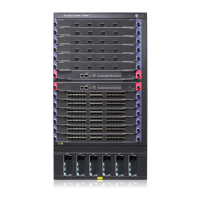77
then the BFD session is established based on the negotiated discriminator values. Such a BFD
session is used for connectivity detection of an LSP from the local device to the remote device.
Configuration prerequistes
• The BFD session parameters configured on the loopback interface whose IP address is configured
as the MPLS LSR ID are used, and the BFD packets use the MPLS LSR ID as the source address.
Before enabling BFD for an LSP, you must configure an IP address for the loopback interface and
configure the IP address as the MPLS LSR ID. You can also configure BFD session parameters for the
loopback interface as needed. For more information about BFD, see High Availability
Configuration Guide.
• To establish a static BFD session, make sure there is already an LSP from the local device to the
remote device and an LSP from the remote device to the local device.
Configuration guidelines
• You cannot establish both a static BFD session and a dynamic BFD session for the same LSP.
• After you establish a static BFD session, you cannot modify the discriminator values of the BFD
session.
• In a BFD session for detecting LSP connectivity, the ingress node always operates in active mode
and the egress node always operates in passive mode. The bfd session init-mode command does
not take effect on the ingress and egress nodes of such a BFD session. Even if you configure the two
nodes to both operate in passive mode, the BFD session can still be successfully established.
• BFD for MPLS LDP is for detecting the IP connectivity between two remote LDP peers. BFD for LSP is
for detecting the connectivity of LSPs.
Configuration procedure
To configure BFD for LSPs:
Ste
Command
Remarks
1. Enter system view.
system-view N/A
2. Enable LSP verification and
enter the MPLS LSPV view.
mpls lspv Not enabled by default.
3. Configure BFD to detect the
LSP connectivity.
bfd enable destination-address
mask-length [ nexthop
nexthop-address [ discriminator
local local-id remote remote-id ] ]
Not configured by default.
Configuring periodic LSP tracert
The periodic LSP tracert function is for locating faults of an LSP periodically. It detects the consistency of
the forwarding plane and control plane and records detection results into logs. You can check the logs
to know whether an LSP has failed.
If you configure BFD as well as periodic tracert for an LSP, once the periodic LSP tracert function detects
an LSP fault or inconsistency of the forwarding plane and control plane, the BFD session for the LSP is
deleted and a new BFD session is established according to the control plane.
To configure the periodic LSP tracert function:

